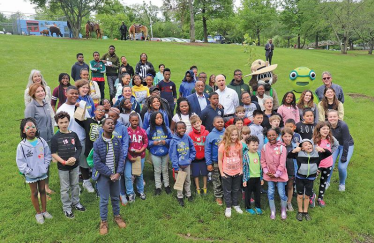Baltimore Mayor Bernard C. “Jack” Young (center in blue blazer) surrounded by Baltimore City students after signing the Children’s Outdoor Bill of Rights at Middle Branch Park. (Photo: Delaney McPherson, National Wildlife Federation)
About 24 percent — or over 4 million — of the Chesapeake watershed’s 18 million residents are children under the age of 18. They are the region’s future. And conservation’s future.
Most children (and adults) — more than 70 percent of the population — live within urban areas. We know the children of today spend less time outdoors than those growing up in past decades. This is probably even more true of children living in urban communities. How do we ensure these kids are provided with a base of protected lands that supports their values? Perhaps it’s grounded in articulating children’s outdoor rights.
Baltimore Mayor Bernard C. “Jack” Young recently announced a “Children’s Outdoor Bill of Rights” stating children in Baltimore have the right to:
- Breathe fresh air
- Splash in clean streams, ponds, rivers and the Chesapeake Bay
- Explore safe and inviting forests and wild spaces
- Grow a garden and eat fresh fruits and vegetables
- Play in vibrant neighborhoods, schoolyards and parks
- Understand and feel connected to their city’s unique ecosystem
- Develop confidence in outdoor skills and recreation
- Work with neighborhood mentors in nature
- Have space for agency and action
Read more about Baltimore’s initiative in this Bay Journal story.
The idea of a children’s outdoor bill of rights has been around for a while and several states and cities have adopted them, including Maryland in 2009. The Children and Nature Network is working with the National League of Cities to assist these efforts through a Cities Connecting Children to Nature Initiative.
A number of the rights listed in the Baltimore declaration speak to what land protection can or should provide, both in cities, and in the ways cities are connected to surrounding landscapes. How does land protection maintain and enhance a network of “safe and inviting forests and wild spaces” for urban residents? Or provide space for city children to “grow and eat fresh fruits and vegetables?” And so on.
The way conservationists answer these questions is crucial to the quality of life for kids living in cities, but also likely vital to ensuring continuing support for land conservation programs themselves.
Lightning Update is a regular communication of the Chesapeake Conservation Partnership. Any opinions expressed are those of the authors and do not necessarily reflect positions of the Partnership or member organizations.
To share a success story, news, or important event, send your information to:
Support for the Chesapeake Conservation Partnership is provided by:
National Park Service Chesapeake
EPA Chesapeake Bay Program
USDA Forest Service
Pennsylvania Department of Conservation & Natural Resources
Maryland Department of Natural Resources
Virginia Outdoors Foundation
US Fish & Wildlife Service
Chesapeake Conservancy
The Chesapeake Conservation Partnership is co-convened by:




